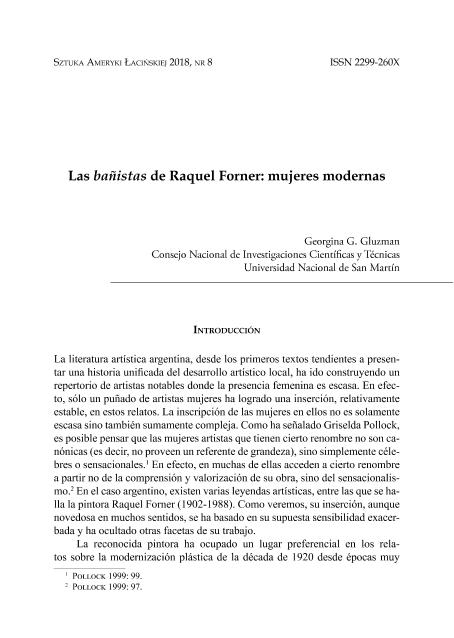Mostrar el registro sencillo del ítem
dc.contributor.author
Gluzman, Georgina Gabriela

dc.date.available
2022-11-08T13:22:44Z
dc.date.issued
2018-06
dc.identifier.citation
Gluzman, Georgina Gabriela; Las bañistas de Raquel Forner: Mujeres modernas; Instituto Polaco de Investigación del Arte Mundial; Sztuka Ameryki ŁacińSkiej; 8; 6-2018; 97-118
dc.identifier.issn
2299-260X
dc.identifier.uri
http://hdl.handle.net/11336/176860
dc.description.abstract
La pintora argentina Raquel Forner (1902-1988) ocupa un sitio sumamente destacado en la literatura artística nacional, donde su obra aparece con regularidad ya desde el relato fundacional del crítico e historiador del arte José León Pagano a fines de la década de 1930. Su doble inscripción como heroína de la vanguardia y como portadora del estandarte antifascista ha mantenido parcialmente velada su activa participación en la construcción de las diversas variantes de la iconografía de la mujer moderna, un tema relevante en la plástica argentina de las décadas de 1920 y 1930. En el extremo opuesto de las mujeres dolientes que han sostenido su ingreso a las historias del arte nacional, sus mujeres modernas tienen cuerpos fuertes y una gestualidad poderosa. Partiendo de sus una serie de obras asociadas a la figura de la bañista, realizadas en 1928 y 1929, exploraremos la construcción visual de una feminidad moderna, atenta a nuevas actividades y presente en nuevos escenarios. Lejos de ser una peculiaridad de Raquel Forner, este tema permeó la producción de otras artistas que, en diversos medios, se dedicaron a desplegar las características visuales de la nueva apariencia femenina y de los lugares sociales recientemente abiertos a las mujeres. Desde la celebrada fotógrafa Annemarie Heinrich hasta la muy poco conocida pintora Lucrecia Moyano, la preocupación por este tema atravesó la producción de las artistas activas en las décadas de 1920 y 1930.
dc.description.abstract
Argentine painter Raquel Forner (1902-1988) has an outstanding place in the national art historical literature, where her work appears regularly from the founding narrative of critic and art historian José León Pagano in the late 1930s. Her double description as heroine of the avant-garde and as weaver of the antifascist fl ag has kept partially veiled her active participation in the construction of the various variants of the icon ography of the modern woman, a relevant topic in the Argentine art of the 1920s and 1930s. Far from the mourning women that have sustained her entry into the histories of national art, her modern women have strong bodies and powerful gestures. From a series of works associated with the fi gure of the bather, painted in 1928 and 1929, we will explore the visual construction of a modern femininity, interested in new activities and new scenarios. Far from being a peculiarity of Raquel Forner, this subject permeated the production of other artists who, in various media, dedicated themselves to unfold the visual characteristics of the new feminine appearance and of the social places recently opened to the women. From the celebrated photographer Annemarie Heinrich to the very little known painter Lucrecia Moyano, the concern with this subject was commonplace for many women artists of the 1920s and 1930s.
dc.description.abstract
Argentyńska malarka, Raquel Forner (1902-1988), zajmuje wybitną pozycję w krajowej literaturze historycznej, gdzie jej twórczość pojawia się regularnie od momentu utworzenia narracji założycielskiej stworzonej przez historyka sztuki José Leóna Pagano pod koniec lat 30. XX wieku. Przypisywana jej podwójna rola – bohaterki awangardy i twórczyni fl agi antyfaszystowskiej – po części przesłania jej aktywny udział w konstruowaniu różnych wariantów ikonografi i współczesnej kobiety, tematu odgrywającego ważną rolę w argentyńskiej sztuce lat 20. i 30. XX wieku. W odróżnieniu od rozpaczających niewiast, które przetrwały w narodowej historii sztuki, jej kobiety mają silne ciała i potężne gesty. Na podstawie serii prac związanych z postacią kąpiącej się kobiety, namalowanych w latach 1928 i 1929, przebadana została wizualna konstrukcja nowoczesnej kobiecości, zainteresowana nowymi działaniami i nowymi scenariuszami. Temat ten, będący początkowo domeną twórczości Raquel Forner, z czasem przeniknął do dzieł innych artystów, którzy – korzystając z różnych mediów – poświęcili się rozwijaniu cech wizualnych nowego kobiecego wyglądu i nowej pozycji kobiety w społeczeństwie. Temat ten był powszechne podejmowany przez wiele artystek w latach 20. i 30. Odnajdujemy go w pracach znanej fotografki Annemarie Heinrich, ale także w dziełach mało znanej malarki Lucrecii Moyano.
dc.format
application/pdf
dc.language.iso
spa
dc.publisher
Instituto Polaco de Investigación del Arte Mundial
dc.rights
info:eu-repo/semantics/openAccess
dc.rights.uri
https://creativecommons.org/licenses/by-nc-sa/2.5/ar/
dc.subject
RAQUEL FORNER
dc.subject
MUJER NUEVA
dc.subject
ARTE ARGENTINO
dc.subject.classification
Arte, Historia del Arte

dc.subject.classification
Arte

dc.subject.classification
HUMANIDADES

dc.title
Las bañistas de Raquel Forner: Mujeres modernas
dc.title
Las bañistas of Raquel Forner: Modern Women
dc.title
Las bañistas autorstwa Raquel Forner: Współczesne kobiety
dc.type
info:eu-repo/semantics/article
dc.type
info:ar-repo/semantics/artículo
dc.type
info:eu-repo/semantics/publishedVersion
dc.date.updated
2022-11-07T10:07:40Z
dc.journal.number
8
dc.journal.pagination
97-118
dc.journal.pais
Polonia

dc.journal.ciudad
Varsovia
dc.description.fil
Fil: Gluzman, Georgina Gabriela. Consejo Nacional de Investigaciones Científicas y Técnicas; Argentina. Universidad Nacional de San Martín. Instituto de Altos Estudios Sociales; Argentina
dc.journal.title
Sztuka Ameryki ŁacińSkiej
dc.relation.alternativeid
info:eu-repo/semantics/altIdentifier/url/https://czasopisma.marszalek.com.pl/images/pliki/sal/8/sal805.pdf
Archivos asociados
